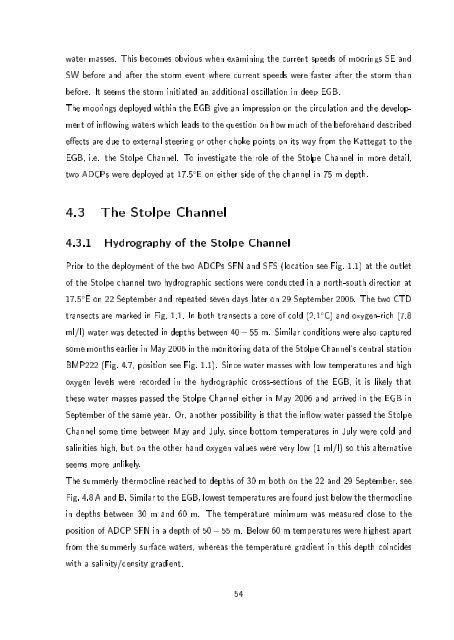Baltic Sea
Baltic Sea
Baltic Sea
You also want an ePaper? Increase the reach of your titles
YUMPU automatically turns print PDFs into web optimized ePapers that Google loves.
water masses. This becomes obvious when examining the current speeds of moorings SE and<br />
SW before and after the storm event where current speeds were faster after the storm than<br />
before. It seems the storm initiated an additional oscillation in deep EGB.<br />
The moorings deployed within the EGB give an impression on the circulation and the development<br />
of inowing waters which leads to the question on how much of the beforehand described<br />
eects are due to external steering or other choke points on its way from the Kattegat to the<br />
EGB, i.e. the Stolpe Channel. To investigate the role of the Stolpe Channel in more detail,<br />
two ADCPs were deployed at 17.5 ◦ E on either side of the channel in 75 m depth.<br />
4.3 The Stolpe Channel<br />
4.3.1 Hydrography of the Stolpe Channel<br />
Prior to the deployment of the two ADCPs SFN and SFS (location see Fig. 1.1) at the outlet<br />
of the Stolpe channel two hydrographic sections were conducted in a north-south direction at<br />
17.5 ◦ E on 22 September and repeated seven days later on 29 September 2006. The two CTD<br />
transects are marked in Fig. 1.1. In both transects a core of cold (2.1 ◦ C) and oxygen-rich (7.8<br />
ml/l) water was detected in depths between 40 − 55 m. Similar conditions were also captured<br />
some months earlier in May 2006 in the monitoring data of the Stolpe Channel's central station<br />
BMP222 (Fig. 4.7, position see Fig. 1.1). Since water masses with low temperatures and high<br />
oxygen levels were recorded in the hydrographic cross-sections of the EGB, it is likely that<br />
these water masses passed the Stolpe Channel either in May 2006 and arrived in the EGB in<br />
September of the same year. Or, another possibility is that the inow water passed the Stolpe<br />
Channel some time between May and July, since bottom temperatures in July were cold and<br />
salinities high, but on the other hand oxygen values were very low (1 ml/l) so this alternative<br />
seems more unlikely.<br />
The summerly thermocline reached to depths of 30 m both on the 22 and 29 September, see<br />
Fig. 4.8 A and B. Similar to the EGB, lowest temperatures are found just below the thermocline<br />
in depths between 30 m and 60 m. The temperature minimum was measured close to the<br />
position of ADCP SFN in a depth of 50 − 55 m. Below 60 m temperatures were highest apart<br />
from the summerly surface waters, whereas the temperature gradient in this depth coincides<br />
with a salinity/density gradient.<br />
54



